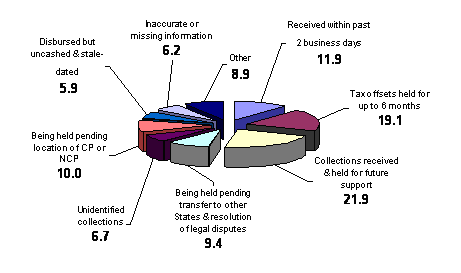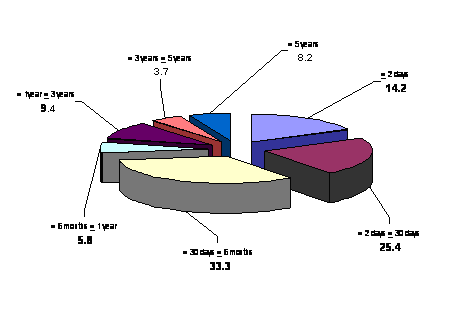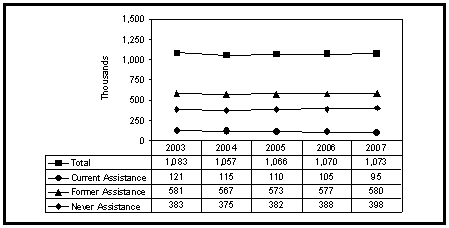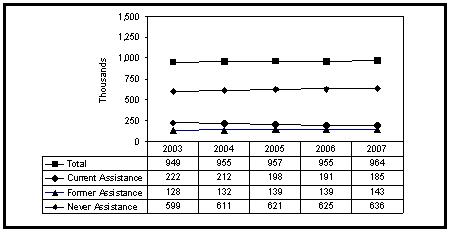

|
|---|
 |
||||
|---|---|---|---|---|
|
|
|
|||
| ACF Home | Services | Working with ACF | Policy/Planning | About ACF | ACF News | HHS Home | ||||
Questions?
|
Privacy
|
Site Index
|
Contact Us
|
Download Reader™
|
|---|
April 2008
Department of Health and Human Services
Administration for Children and Families
Office of Child Support Enforcement
View alternative version of Preliminary Report FY2007 (Adobe PDF, 902KB)
Nationwide, Regional, and State Box Scores, FY 2007
Program Charts and Graphs, FY 2007
Appendix
OCSE Data Report forms are available on the OCSE web site at: http://www.acf.hhs.gov/programs/cse/forms/
This Office of Child Support Enforcement (OCSE) Preliminary Report highlights financial and statistical program achievements for the Federal Fiscal Year (FFY) 2007. The information is retrieved from State-submitted reports on program status sent to the Federal government quarterly for financial, and annually, for statistical data. Data in the report reveal that almost $25 billion in child support payments was collected and distributed; almost $23 billion was distributed to families or Foster Care agencies; 1.7 million paternities were established and acknowledged; and over 1.1 million child support orders were established.
Caseload OCSE defines a child support case as a parent (mother, father, or putative father) who is now or eventually may be obligated under law for the support of a child or children receiving services under the Child Support Program, Title IV-D of the Social Security Act. A current assistance case is one in which the children are:
(1) recipients of Temporary Assistance for Needy Families (TANF) under Title IV-A of the Social Security Act or;
(2) entitled to Foster Care maintenance payments under Title IV-E of the Social Security Act.
In addition, the children’s support rights have been assigned by a caretaker to the State and a referral to the State IV-D agency has been made. A former assistance case is a case in which the children were formerly receiving Title IV-A (AFDC or TANF) or Title IV-E (Foster Care) services. A never assistance case is a case in which the children are receiving services under the Title IV-D program, but are not currently eligible for and have not previously received TANF and Foster Care assistance. This includes cases in which the family is receiving child support services as a result of a written application (including cases in which children are receiving State, not Title IV-E, Foster Care services) or a case in which they are Medicaid recipients not receiving additional assistance.
In FY 2007, there were almost 15.8 million cases in the Child Support Enforcement Program. This represents a slight decrease of 0.6 percent in the caseload from FY 2006. In FY 2007, there were 2.1 million current assistance cases, a decrease of 8.5 percent from FY 2006; 7.2 million former assistance cases, a decrease of 1.0 percent from FY 2006; and 6.4 million never assistance cases reported, an increase of 2.9 percent from FY 2006 (Table 2). The decrease in the overall caseload was largely due to a drop in the number of current assistance and former assistance families between FY 2006 and FY 2007.
Paternities Established Paternity establishment involves the legal establishment of fatherhood for a child. One way paternity can be established is by a voluntary acknowledgement signed by both parents as part of an in-hospital or other acknowledgement program.
In FY 2007, there were almost 640,000 paternities established and nearly 1.1 million in-hospital and other paternities acknowledged (Table 2). Overall, paternity was established or acknowledged for 1.7 million children, a 1.7 percent increase from the previous year.
Orders Established There were over 1.3 million child support orders established in FY 2007. This represents a 14.3 percent increase over the number established in 2006 (Table 2). Current assistance orders accounted for 16.2 percent of these orders, former assistance orders accounted for 35.4 percent, and never assistance orders accounted for 48.4 percent of the support orders established.
Collections Total distributed child support collections amounted to almost $25 billion in FY 2007 (Tables 1, 3, and 7), a 3.8 percent increase over the amount collected in FY 2006. Child support payments are collected through various methods, including, for example income withholding; unemployment compensation interception; and State or Federal tax refund offsets. In FY 2007, 69.7 percent of payments were collected via income withholding; 1.6 percent from unemployment compensation; 6.0 percent from tax offsets; 18.2 percent from other sources; and 4.5 percent from other States.
Collections per Full-Time Equivalent (FTE) Staff There were over 60,000 FTE staff working in the States and jurisdictions in the Child Support Enforcement Program in FY 2007 (Table 2). Nationally, the amount of child support collected per FTE was over $413,000 compared to the $396,000 per FTE in FY 2006, a 4.4 percent increase.
Expenditures Total administrative expenditures were nearly $5.6 billion in FY 2007, a 0.6 percent increase over those in FY 2006. The Federal Share of expenditures was nearly $3.7 billion, and the State share was $1.9 billion (Table 1).
Collections Due and Distributed The total amount of current support due for FY 2007 was over $30 billion. Approximately $19 billion, or 61 percent of that amount was collected and distributed, an increase of 4.2 percent over the amount of current support collected and distributed in FY 2006. The total amount of arrearages reported for all previous fiscal years was over $107 billion and over $7 billion of these arrearages was collected and distributed in FY 2007, an increase of 2.4 percent over the amount of arrears collected and distributed in FY 2006 (Table 5).
There were over 11.3 million cases with arrears due and over 6.9 million (61 percent) of these cases had collections in FY 2007 (Table 6). Also, in FY 2007, increases were noted for total cases in which a collection was made. Preliminary data reveal that there are 8.7 million cases with collections, which represents a 1.8 percent increase over the number of total cases with collections in FY 2006 (Table 2).
The total cases with an order established in FY 2007 were over 12.3 million, which represents a 0.8 percent increase over the number of cases with orders established in the previous fiscal year (Table 2).
The total number of children in the Title IV-D caseload in FY 2007 was over 17.1 million, a 0.8 percent decrease from the 17.3 million children in the Title IV-D caseload in FY 2006 (Table 2).
In FY 2007, there were 12 comprehensive Tribal Child Support Enforcement Programs. Tribes distributed nearly $15.7 million in total collections in FY 2007 (Table 16), a 21.6 percent increase from the nearly $12.9 million in FY 2006. There were 27,708 cases in the Tribal Program caseload (Table 13), a 7.0 percent increase from FY 2006; over 14,000 children with paternity established (Table 14), a 4.9 percent increase from FY 2006; and a total of 12,567 support orders established (Table 15), a 37.7 percent increase from FY 2006.
The attached tables and charts provide further preliminary detail regarding collections, expenditures, caseload, paternities, orders established, and other program statistics, related to both the Child Support Enforcement and Tribal Child Support Enforcement Programs for FY 2007.
Table 1 - Financial Overview, FY 2006 and FY 2007
Table 2 - Statistical Overview, FY 2006 and FY 2007
Table 3 - Total Distributed Collections, FY 2007
Table 4 - Statistical Program Status, FY 2007
Table 5 - Current and Arrears Collections Due and Distributed, FY 2007
Table 6 - Cases with Arrears Due and Cases Paying Towards Arrears, FY 2007
Table 7 - Collections and Expenditures, FY 2007
Table 8 - Paternity Establishment, FY 2007
Table 9 - Net Undistributed Collections (UDC), FY 2007
Table 10 - Medical Support and Arrears-Only Cases with Orders Established, FY 2007
Table 11 - Health Insurance Provided as Ordered for FY 2007
Table 12 - Unaudited Incentive Performance Scores, FY 2007
Table 13 - Tribal Program Caseload for Two Consecutive Fiscal Years
Table 14 - Tribal Program Children with Paternities Established for Two Consecutive Fiscal Years
Table 15 - Tribal Program Support Orders Established for Two Consecutive Fiscal Years
Table 17 - Tribal Program Expenditures for Two Consecutive Fiscal Years
| NATIONWIDE | % change from FY 06 | |
| Collections Distributed | $24,854,768,488 | 3.8% |
| - Current Assistance | $946,283,222 | -4.0% |
| - Former Assistance | $9,469,870,384 | 2.5% |
| - Never Assistance | $11,322,297,160 | 3.2% |
| - Medicaid Assistance | $3,116,317,722 | 13.8% |
| Total Expenditures | $5,593,864,242 | 0.6% |
| Cost Effectiveness ($ Change) | $4.73 | $0.15 |
| Paternities & Acknowledgements | 1,729,141 | 1.7% |
| Orders Established | 1,177,589 | 1.6% |
| Full Time Equivalent Staff | 60,104 | -0.5% |
| Total Caseload | 15,755,322 | -0.6% |
| - Current Assistance | 2,136,693 | -8.5% |
| - Former Assistance | 7,194,998 | -1.0% |
| - Never Assistance | 6,423,631 | 2.9% |
| Net Undistributed Collections | $471,977,847 | -2.8% |
| Arrears Amounts Due | $107,248,465,839 | -2.0% |
Cases
Figure 1 Total and Percentage of Child Support Caseload by Current, Former, and Never Assistance for Five Consecutive Fiscal Years
Figure 2 Total and Percentage of Cases With and Without Support Orders Established for Five Consecutive Fiscal Years
Figure 3 Number of Cases for Which a Collection Was Made by Current, Former, and Never Assistance for Five Consecutive Fiscal Years
Paternities Acknowledged
Figure 4 IV-D and Statewide Paternities Established or Acknowledged for Five Consecutive Fiscal Years
Collections
Figure 5 Total Distributed Collections by Current, Former, and Never Assistance, and Medicaid Cases, FY 2007
Figure 6 Total Collections Received by Method of Collections, FY 2007
Figure 7 Total Distributed Collections by TANF/Foster Care and Non-TANF Collections for Five Consecutive Fiscal Years
Figure 8 Undistributed Collections (UDC) by Category and Age, FY 2007
Figure 9 Interstate Collections: Collections Sent to Other States for Five Consecutive Fiscal Years
Interstate
Figure 10 Interstate Cases: Cases Sent to and Received from Another State for Five Consecutive Fiscal Years
Expenditures
Figure 11 Total Administrative Expenditures for Five Consecutive Fiscal Years
Figure 12 Total ADP Expenditures for Five Consecutive Fiscal Years
Number of Children
Figure 13 Total Number of Children in the IV-D Program for Five Consecutive Fiscal Years
Federal Parent and Locator Service (FPLS)
Figure 14 Number of Unique Persons Matched and Number of Persons in the Federal Case Registry (FCR) by Participant Type for Five Consecutive Fiscal Years
Figure 15 Federal Offset Collections for Five Processing Years
Figure 1: Total and Percentage of Child Support Caseload by Current, Former, and Never Assistance for Five Consecutive Fiscal Years

In FY 2007, the total child support caseload decreased to 15.8 million cases. This was due in part to a decrease in current assistance cases. Families formerly on public assistance comprise the largest portion of caseload
Figure 2: Total and Percentage of Cases With and Without Support Orders Established for Five Consecutive Fiscal Years

Although the total child support caseload decreased in FY 2007, cases with orders increased by 1 percentage point over FY 2006.
Figure 3: Number of Cases for Which a Collection Was Made by Current, Former, and Never Assistance for Five Consecutive Fiscal Years

At 8.7 million, the number of IV-D cases for which a collection was made increased by 2.4 percent in FY 2007 over FY 2006.
Figure 4: IV-D and Statewide Paternities Established or Acknowledged1 for Five Consecutive Fiscal Years

In FY 2007, a total of 1.7 million paternities were established and acknowledged - largely through in-hospital and other
Figure 5: Total Distributed Collections by Current, Former, and Never Assistance, and Medicaid Cases, FY 2007

Most child support collections are for families who are not on assistance. Former assistance and never assistance families received 84 percent of the child support collections in FY 2007.
Figure 6: Total Collections Received by Method of Collections, FY 2007

Wage withholding continues to be the most effective way of collecting child support.
Figure 7: Total Distributed Collections by TANF/Foster Care and Non-TANF Collections for Five Consecutive Fiscal Years

Non-TANF collections continued to increase in FY 2007. TANF/FC collections declined during the same period, mostly associated with the decrease in the TANF/FC caseload.
Figure 8: Undistributed Collections (UDC) by Category and Age, FY 2007


Collections held for future support was the main reason collections were undistributed in FY 2007.
Figure 9:Interstate Collections: Collections Sent to Other States for Five Consecutive Fiscal Years

In FY 2007, the amount of collections sent to other States showed a 15.3 percent increase over FY 2003.
Figure 10: Interstate Cases: Cases Sent to and Received From Another State for Five Consecutive Fiscal Years


The total number of interstate cases sent to another State exceed interstate cases received from another State over the past five years.
Figure 11: Total Administrative Expenditures for Five Consecutive Fiscal Years

In FY 2007, the States’ level of spending remained unchanged from FY 2006.
Figure 12: Total Automated Data Processing (ADP) Expenditures for Five Consecutive Fiscal Years

Automated Data Processing (ADP) expenditures decreased 1.6 percent in FY 2007.
Figure 13:Total Number of Children in IV-D Program for Five Consecutive Fiscal Years

In FY 2007, the number of children in the child support program decreased 0.8 percent over the previous year.
Figure 14: Number of Unique Persons Matched and Number of Persons in the Federal Case Registry by Participant Type for Five Consecutive Fiscal Years

The number of unique persons matched decreased by 1 percent between FY 2006 and FY 2007. Children make up the largest portion of the participant types.
Figure 15: Federal Offset Collections for Five Processing Years

Federal Offset collections for 2007 were $1.69 billion, a 5.8 percent increase over the previous year
|
CSPIA INCENTIVE MEASURE FORMULAS | |
|
INCENTIVE MEASURE |
FORM AND LINE NUMBERS |
|
PATERNITY ESTABLISHMENT PERCENTAGE (PEP): IV-D | |
|
Number of Children in the Caseload
in the FY or as of the End of the FY
Who Were Born Out-of-Wedlock
with Paternity Established or Acknowledged |
OCSE-157, Line 6 |
|
PATERNITY ESTABLISHMENT PERCENTAGE (PEP): STATEWIDE | |
Number of Minor Children in the State
Born Out-of-Wedlock with
Paternity Established or Acknowledged During the
FY |
OCSE-157, Line 9 |
|
SUPPORT ORDER ESTABLISHMENT | |
|
Number of IV-D Cases with Support Orders |
OCSE-157, Line 2 |
|
CURRENT COLLECTIONS | |
|
Amount Collected for Current Support in IV-D Cases |
OCSE-157, Line 25 |
|
ARREARAGE COLLECTIONS | |
|
Number of IV-D Cases Paying Toward Arrears |
OCSE-157, Line 29 |
|
COST-EFFECTIVENESS | |
|
Total IV-D Dollars Collected |
OCSE-34A, Lines 8 + 5 + 13 of column (G) |
|
STATE COLLECTION BASE | |
|
2 times (Current Assistance + Former Assistance |
OCSE-34A: |
How an Incentive Payment is Determined
Because of the complexity of the incentives formula set forth in section 458 of the Social Security Act, we have included an example of how the system would work in a particular year for State A. Let's make the following assumptions regarding State A (See table A):
The maximum incentive for State A is:
Table A
|
Measure |
State A's Performance Level |
Applicable Percent based on Performance |
Weight |
State A's Collection Base (assumed to be $50,000,000) |
|
Paternity Establishment |
93% |
100% |
1.00 |
$50,000,000 |
|
Order Establishment |
74% |
88% |
1.00 |
$44,000,000 |
|
Current Collections |
59% |
69% |
1.00 |
$34,500,000 |
|
Arrearage Collections |
60% |
70% |
0.75 |
$26,250,000 |
|
Cost-Effectiveness |
$4.40 |
80% |
0.75 |
$30,000,000 |
|
State A's Maximum Incentive Base Amount |
$184,750,000 |
Table B
|
State |
Maximum Incentive Base Amounts |
State's Share of $318,750,000 |
Incentive Payment Pool $461,000,000 |
|
A |
$184,750,000 |
0.58 |
$267,199,216 |
|
B |
$84,000,000 |
0.26 |
$121,487,059 |
|
C |
$50,000,000 |
0.16 |
$72,313,725 |
|
Totals |
$318,750,000 |
1.00 |
$461,000,000 |
Table C3
If the Paternity Establishment or Support Order Performance Level Is:
|
At Least: |
But Less Than: |
The Applicable Percentage Is: |
At Least: |
But Less Than: |
The Applicable Percentage Is: |
|
|
80% |
100% |
64% |
65% |
74% |
||
|
79% |
80% |
98% |
63% |
64% |
73% |
|
|
78% |
79% |
96% |
62% |
63% |
72% |
|
|
77% |
78% |
94% |
61% |
62% |
71% |
|
|
76% |
77% |
92% |
60% |
61% |
70% |
|
|
75% |
76% |
90% |
59% |
60% |
69% |
|
|
74% |
75% |
88% |
58% |
59% |
68% |
|
|
73% |
74% |
86% |
57% |
58% |
67% |
|
|
72% |
73% |
84% |
56% |
57% |
66% |
|
|
71% |
72% |
82% |
55% |
56% |
65% |
|
|
70% |
71% |
80% |
54% |
55% |
64% |
|
|
69% |
70% |
79% |
53% |
54% |
63% |
|
|
68% |
69% |
78% |
52% |
53% |
62% |
|
|
67% |
68% |
77% |
51% |
52% |
61% |
|
|
66% |
67% |
76% |
50% |
51% |
60% |
|
|
65% |
66% |
75% |
0% |
50% |
0% |
|
Table D4
If the Current Collections or Arrearage Collections Performance Level Is:
|
At Least: |
But Less Than: |
The Applicable Percentage Is: |
At Least: |
But Less Than: |
The Applicable Percentage Is: |
|
|
80% |
100% |
59% |
60% |
69% |
||
|
79% |
80% |
98% |
58% |
59% |
68% |
|
|
78% |
79% |
96% |
57% |
58% |
67% |
|
|
77% |
78% |
94% |
56% |
57% |
66% |
|
|
76% |
77% |
92% |
55% |
56% |
65% |
|
|
75% |
76% |
90% |
54% |
55% |
64% |
|
|
74% |
75% |
88% |
53% |
54% |
63% |
|
|
73% |
74% |
86% |
52% |
53% |
62% |
|
|
72% |
73% |
84% |
51% |
52% |
61% |
|
|
71% |
72% |
82% |
50% |
51% |
60% |
|
|
70% |
71% |
80% |
49% |
50% |
59% |
|
|
69% |
70% |
79% |
48% |
49% |
58% |
|
|
68% |
69% |
78% |
47% |
48% |
57% |
|
|
67% |
68% |
77% |
46% |
47% |
56% |
|
|
66% |
67% |
76% |
45% |
46% |
55% |
|
|
65% |
66% |
75% |
44% |
45% |
54% |
|
|
64% |
65% |
74% |
43% |
55% |
53% |
|
|
63% |
64% |
73% |
42% |
43% |
52% |
|
|
62% |
63% |
72% |
41% |
42% |
51% |
|
|
61% |
62% |
71% |
40% |
41% |
50% |
|
|
60% |
61% |
70% |
0% |
40% |
0% |
|
Table E5
If the Cost-Effectiveness Performance Level Is:
|
At Least: |
But Less Than: |
The Applicable Percentage Is: |
|
5.00 |
100% |
|
|
4.50 |
4.99 |
90% |
|
4.00 |
4.50 |
80% |
|
3.50 |
4.00 |
70% |
|
3.00 |
3.50 |
60% |
|
2.50 |
3.00 |
50% |
|
2.00 |
2.50 |
40% |
|
0.00 |
2.00 |
0% |
Table F
Mandated Incentive Pool Payment, FY 2000-2008
The incentive payment pool is:
For each fiscal year following fiscal year 2008, the incentive payment pool will be multiplied by the percentage increase in the CPI between the two preceding years. For example, for fiscal year 2009, if the CPI increases by one percent between fiscal years 2007 and 2008, then the incentive pool for fiscal year 2009 would be a one percent increase over the $483,000,000 incentive payment pool for fiscal year 2008, or $487,830,000.
[1]Because the measure has less weight.
[2]Because the measure has less weight.
[3]Use this table to determine the maximum incentive levels for the paternity establishment and support order performance measures.
[4]Use this table to determine the maximum incentive levels for the current and arrearage support collections performance measures.
[5]Use this table to determine the maximum incentive level for the cost-effectiveness performance measure.
Download FREE Adobe Acrobat® Reader™ to view PDF files located on this site.
OCSE Home
|
Press Room
|
Events Calendar
|
Publications
|
Systems:
FPLS
|
FIDM
|
State and Tribal
|
State Profiles
Resources:
Grants Information
|
Información en Español
|
International
|
Federal/State Topic Search (NECSRS)
|
Tribal
|
Virtual Trainer's Library